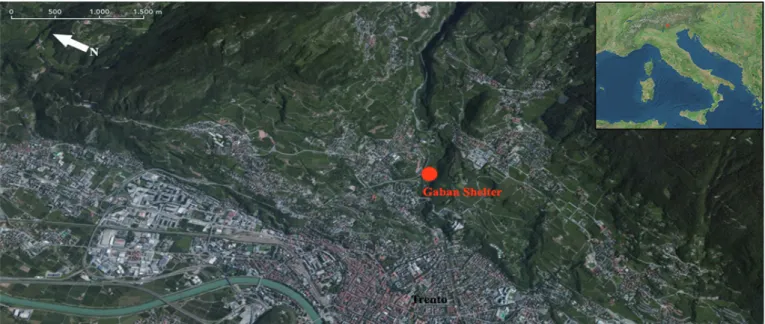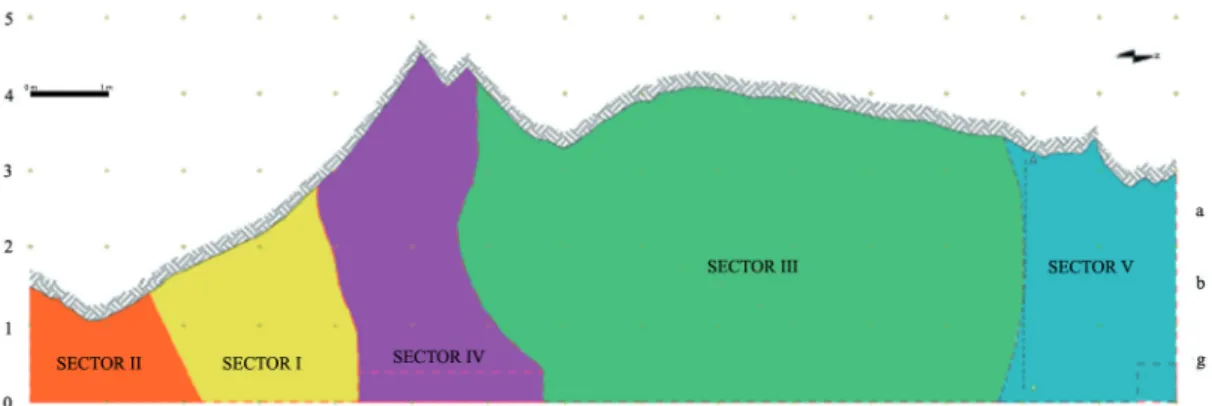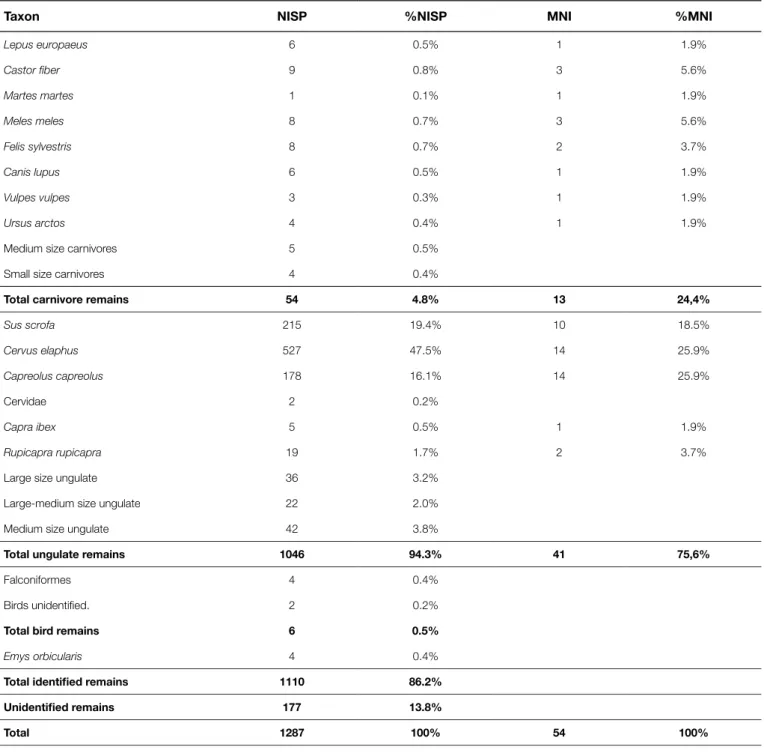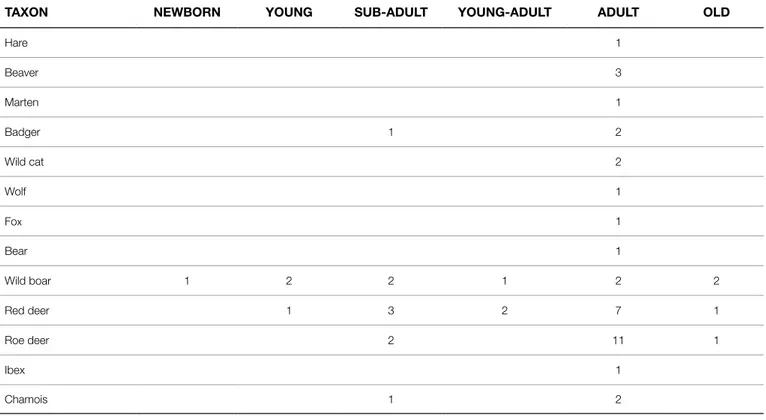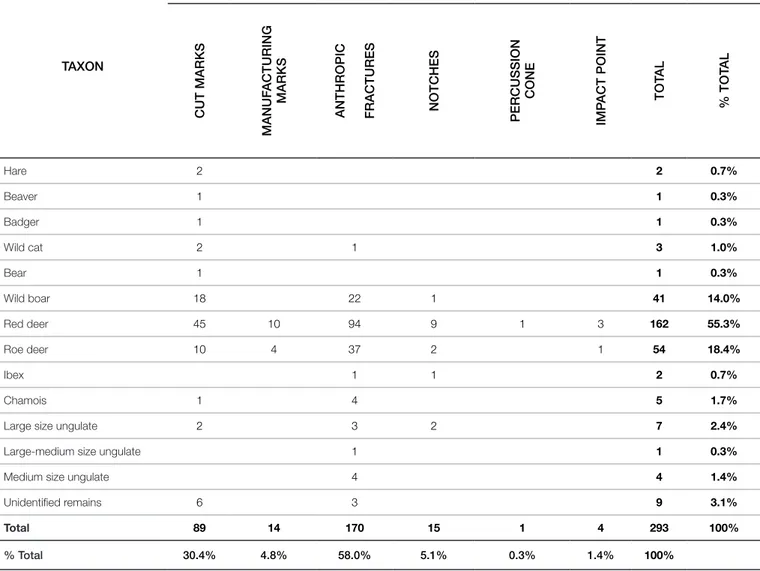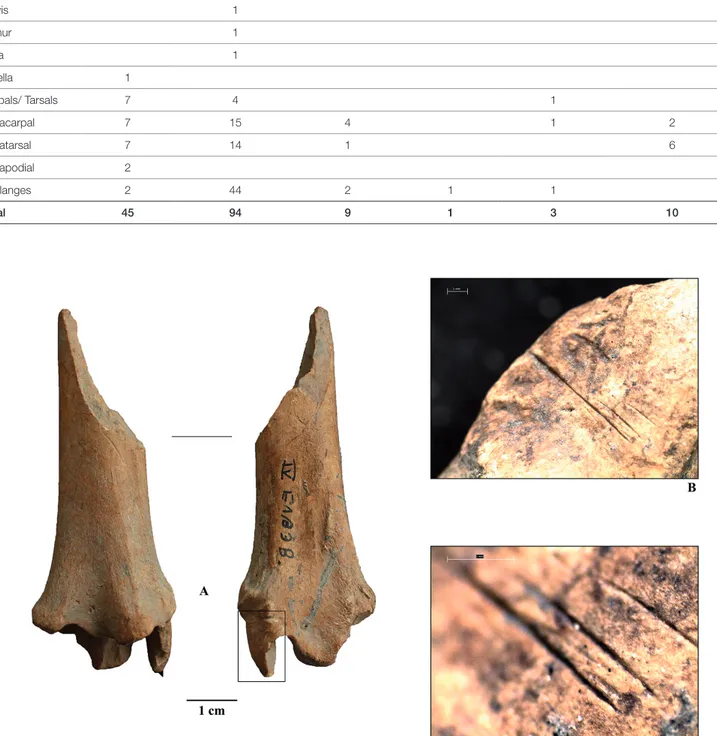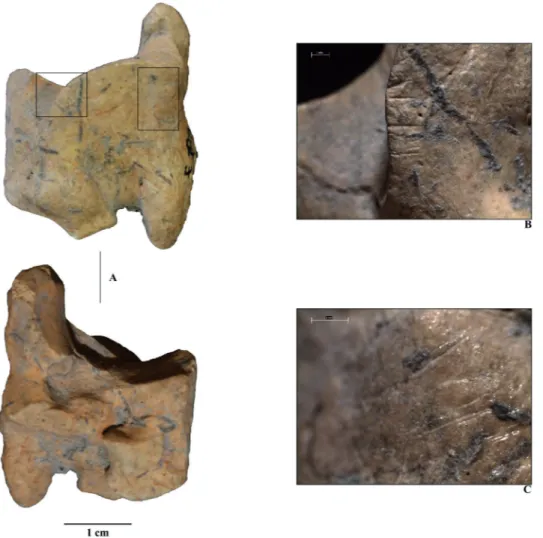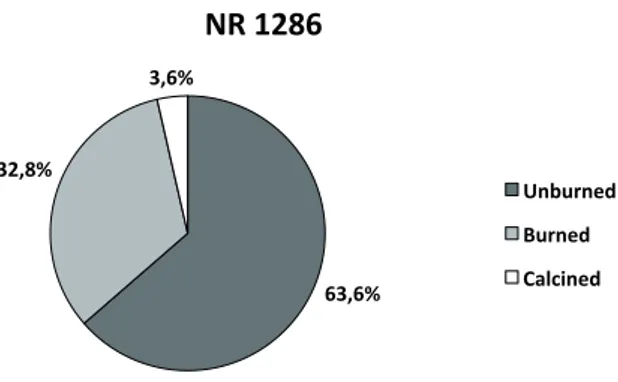Article
Exploitation of faunal resources at Riparo Gaban (Trento, Italy)
during the Late Mesolithic period: preliminary results
of archaeozoological and taphonomical analysis
Ursula Thun Hohenstein
1*, Marco Bertolini
1, Irene Valverde
1,2, Giampaolo Dalmeri
3, Annaluisa
Pedrotti
41 Laboratorio di Archeozoologia e Tafonomia, Dipartimento di Studi Umanistici, Università di Ferrara, C.so Ercole I d’Este 32 - 44121 Ferrara. 2 Departamento de Hístoria, Universidad de Santiago de Compostela, Plaza de la Universidad,1 - 15782 Santiago de Compostela, España. 3 MUSE, Museo delle Scienze di Trento, Corso del Lavoro e della Scienza 3 - 38122 Trento
4 Dipartimento di Lettere e Filosofia, Università degli Studi di Trento, Via Tommaso Gar, 14 - 38122 Trento
Key words
• Archaeozoology • Taphonomy • Castelnovian • Riparo Gaban • Adige Valley - Trento • ItalyParole chiave
• Archeozoologia, • Tafonomia • Castelnoviano • Riparo Gaban • Val d'Adige - Trento • Italia* Corresponding author: e-mail: [email protected]
Summary
Riparo Gaban is a rockshelter located at about 270m a.s.l., near Trento, in a narrow lateral valley on the left bank of river Adige, Northern Italy. This site gives name to the so called “Gaban group” occu-pying Trento area during the spread of neolithisation, at the end of the VI millennium cal BC. Despite some gaps, the excavations by Bernardino Bagolini in sectors I to V from 1971 to 1979, revealed an impressive stratigraphic series attesting several occupations from late IX to mid-II millennium cal BC. The best known finds unearthed in Mesolithic (Sauveterrian and Castelnovian) and Neolithic layers are undoubtedly object of high artistic value, and realised on bone, antler, and stone. The analysed faunal assemblages derive from Castelnovian levels (IV Sector US E1-4) and are characterised by a high degree of fragmentation due to intentional bones fracturing for marrow extraction.The faunal remains belong mostly to ungulates: red deer, boar and roe deer are the most common species followed by a sporadic presence of ibex and chamois. Small wild mammals and carnivores are poorly attested in all layers. This study reports preliminary taphonomical results of Castelnovian faunal assemblages, in order to identify modifications related to the exploitation of animal carcasses.
Riassunto
Sfruttamento delle risorse animali al Riparo Gaban nel Mesolitico: risultati preliminari delle analisi archeo-zoologiche e tafonomiche - Riparo Gaban rappresenta uno dei principali siti di riferimento per lo studio del processo di neolitizzazione nelle Alpi e dà il nome al gruppo presente in Trentino durante la diffusione della nuova economia produttiva, alla fine del VI millennio BC cal. Gli scavi condotti da Bernardino Bago-lini dal 1971 al 1979 nei sett. I-V hanno messo in luce una sezione stratigrafica che documenta una fre-quentazione, con alcune lacune, dalla fine del IX alla metà del II millennio a.C. cal. I reperti più noti sono senz’altro gli oggetti di alto valore artistico portati alla luce nei livelli del Mesolitico (Sauveterriano e Castel-noviano) e Neolitico che sono realizzati su osso, palco e pietra. L’insieme faunistico analizzato proviene dai livelli castelnoviani (Settore IV US E1-4) e si caratterizza per un elevato grado di frammentazione a causa della fratturazione intenzionale per l’estrazione del midollo. Gli animali maggiormente rappresenta-ti sono cervo, cinghiale e capriolo seguirappresenta-ti da una sporadica presenza di stambecco e camoscio. I mam-miferi selvatici di piccole dimensioni ed i carnivori sono scarsamente. Qui, vengono presentati i risultati preliminari delle analisi tafonomicheper ricostruire le modalità di sfruttamento delle carcasse animali.
Redazione: Valeria Lencioni e Marco Avanzini
pdf: http://www.muse.it/it/Editoria-Muse/Preistoria-Alpina/Pagine/PA/PA_48-2016.aspx
Thun Hohenstein U., Bertolini M., Valverde I., Dalmeri G., Pedrotti A., 2016 - Exploitation of faunal resources at Riparo Gaban (Trento, Italy) during the Late Mesolithic period: preliminary results of archaeozoological and taphonomical analysis. Preistoria Alpina, 48: 53-62.
2016
ISSN 0393-0157
homepage: http://www.muse.it/it/Editoria-Muse/Preistoria-alpina © 2016 MUSE - Museo delle Scienze, Trento, Italia
Introduction
An important synthesis for the understanding of Mesolithic set-tlement and subsistence strategies in Trentino Alto-Adige, Northern Italy is proposed by R. H. Clark (“The Mesolithic Hunters of the Tren-tino”, 2000). The main aim of this study was to examine both ani-mal resources and lithic material in order to understand Mesolithic subsistence and settlement changes throughout a time span of ca. 3,500 years (Clark, 2000).
Among the analysed sites, Riparo Gaban fauna is composed by a substantial number of 19,023 remains recovered during the field-excavation carried out between 1982 and 1983.
Both Sauveterian and Castelnovian faunal assemblages were characterised by a high degree of fragmentation (Clark, 2000). Red deer, roe deer and wild boar were the most common species fol-lowed by ibex and chamois. Small game mammals and carnivores were poorly attested in all layers (Clark, 2000). Clark work did not analyse faunal remains from a taphonomical point of view, therefore any data defining post-depositional phenomena and any difference in the carcass processing were described.
Recently, a huge faunal assemblage deriving from Castelnovian layers (Sector IV SU E1-4) during the field-excavation by Bernardino Bagolini in 1974 was studied by the Authors.
The aim of this work is to present archaeozoological and tapho-nomical analysis on this unpublished Riparo Gaban faunal assem-blage, in order to collect more data about faunal exploitation from Castelnovian occupations, and describe carcass processing.
The site
Riparo Gaban is located on the left side of Adige Valley (To-masoni et alii, 2013, Koszlowski & Dalmeri, 2002) at 260m a.s.l, in Piazzina di Martignano, just a few kilometres northwest of Trento, Northern Italy (Fig. 1). The rockshelter is located on western slope of Monte Calisio, with an eastern exposure, 29m long, 6m high, 2.5-4m deep, and soars for approximately 80m above the current Adige Valley floor (Bagolini 1980, Kozlowski & Dalmeri, 2002).
This site, discovered in 1970, was systematically excavated from 1971 to 1979 under direction of Bernardino Bagolini, Museo Tridentino di Scienze Naturali (Trento), and then from 1982 to 1983 in collaboration with Alberto Broglio, University of Ferrara and Stefan K. Kozlowski,University of Warsaw.
The explored area of about 60m2 was divided into five sectors (I to V) by B. Bagolini (Fig.2). During the excavations a continuous stratigraphic sequence, spanning from Mesolithic to Early Bronze Ages and partially damaged by three Medieval pits, was highlighted.
Castelnovian layer is about 20cm thick, with a typical whitish appearance and widespread concretion; it was partially damaged in many parts by Medieval pits (Kozlowski & Dalmeri, 2002). Layer E is dated 6968±41 BP uncal (KIA_10363 5979-5726 cal BC 2 σ) on a charcoal sample.
Materials and methods
The analysis were carried out at Laboratory of Archaeozo-ology and Taphonomy, Department of Humanities, University of Ferrara. This faunal sample has for the first time been examined in Ferrara, since it was included neither in Clark’s nor in Griggo’s studies (Kozlowski & Dalmeri, 2002). In order to identify species or genus, a total of 1,286 faunal remains were analysed using the osteological reference collection of our laboratory. When a taxonomical attribution was not possible, the unidentified faunal remains were divided by supposed mammal size (large, medium, small size, including intermediate categories), considering shaft fragments dimension and compact bone thickness. All the bone fragments were measured and, when possible, were the osteo-logical measurements by Von den Driesch (1976) also collected. Taphonomical analysis was carried out using a stereo-micro-scope Leica S6D (6x-40x magnification), with integrated digital camera EC3.
Distinction between climatic and edaphic modifications was performed referring to Beherensmeyer (1978), Malerba & Giacobini (1993), Lyman (1994), Giacobini (1995; 1996). The identification of carnivore and rodent marks was done referring to Binford (1981), Brain (1981), Giacobini (1995), Cilli et al. (2000), Thun Hohenstein (2003). After summarising the state of the literature, have intentional fresh bone fracturing for marrow extraction, post-depositional frac-tures and manufacturing marks been discriminated (Sadek-Kooros, 1972; Myers et al. 1980; Shipman et al., 1984; Johnson 1985; Villa & Mahieu, 1991; Blasco Sancho, 1992; Lyman, 1994; Peretto et al., 1996; Anconetani & Peretto, 1996).
Fig. 1 - Satellite view of the Adige Valley and location of Riparo Gaban (Trento, Northern Italy). / Veduta satellitare della valle dell’Adige e localizzazione del Riparo Gaban (Trento).
Results
Faunal composition
Faunal assemblage is composed of 1,286 bone fragments (Tab. 1). Although the remains identified only by the anatomical point of view (78.3%) were removed from the count, the ratio of identified remains is particularly high (86.2%).
Unidentified remains, usually 80-90% in similar contexts, are surely under-represented. This biased sample depends on the se-lection of bone fragments performed during the excavations, as were unidentified remains smaller than 2cm not collected (A. Pedrotti pers. comm.).
However, this faunal assemblage is very interesting being par-ticularly abundant and well preserved. Red deer is the most rep-resented animal with a total of 527 remains (Tab. 1), followed by wild boar (NISP 215) and roe deer (NISP 178). This association can certainly be correlated to an open wooded habitat, with a thick un-dergrowth near the rock-shelter.
Chamois and ibex are poorly attested by a small number of bone fragments (NISP 19 and 5), due to site location on the valley floor and environmental features (Boscato & Wierer, 2006).
A little amount of identified specimens is present among the carnivore remains (4.8%; Tab. 1). All species are represented by less than ten remains. Wild cat and badger are the animals with a higher NISP followed by wolf, bear and fox (Tab. 1).
Among rodents and lagomorphs, a small number of remains is also attested. Beaver testifies the presence of a nearby stream. Some pond turtle carapace fragments and a humerus suggest a sporadic collection of this animal.
Birds are very scanty in the faunal assemblage (Tab. 1), but three remains belong to a large sized bird of prey, such as a golden eagle.
Exploitation of large mammals
Red deer, wild boar and roe deer were probably the most com-mon species hunted by hunter-gatherers of Riparo Gaban during the Late Mesolithic period. From an anatomical point of view, the red deer is represented by all skeletal portions in the faunal assemblage (Tab. 2). Ribs and vertebrae fragments belonging to a large sized ungulate suggest that the whole red deer carcass was transported into the rock-shelter. It is interesting to emphasise that isolated teeth, carpals, metapodials and phalanges are more abundant than other kind of skeletal elements. This fact conditioned the count of a min-imum number of individuals (MNI), mainly estimated on mandibles and isolated teeth. A total of 14 individuals of different age ratio were counted (Tab. 1). Adults are the most abundant individuals with 10 specimens in whole (Tab. 3). The scarcity of young and sub-adult classes is showed by the presence of deciduous teeth at different use-wear stages and many anatomical elements with unfused epi-physis. A sample of six atrophic canines suggests that males were
the most hunted game.
As far as the wild boar is concerned, elements of the appendic-ular skeleton, such as metapodials and phalanges, are dominating (Tab. 2). On the whole, hind and fore limbs are attested by quite sim-ilar quantities, excluding that was a selection of anatomical portions made in the killing place. Ribs and vertebrae fragments of medium sized ungulates are also found (Tab. 2), suggesting that killed wild boars were entirely transported into the rock-shelter, and then pro-cessed and consumed. The abundance of isolated teeth and man-dibular and maxillary fragments with complete or partially complete dental series have yielded interesting data on wild boar age classes. In effect, unlike the red deer, wild boar age categories show a great-er hetgreat-erogeneity with a balance between young and adults/senile individuals. Young and sub-adults, as suggested by Bull & Payne (1982), are presumably less than two years old, and one-year-old in some cases (Tab. 3). The presence of wild boar female canines could support this occurrence, since the puppies follow their moth-ers until the age of one year, during their displacements in search of the food supply.
Roe deer shows a balanced relationship in body part rep-resentation (Tab. 2) and, as for the other ungulates, its carcass was wholly transported into the rock-shelter; effectively, all the anatomical elements are represented. Nevertheless, a lower occurrence of ele-ments belonging to the forelimb suggests that only some body parts were occasionally brought within the site.
As for red deer and wild boar, the roe deer MNI and age-at-death were estimated on mandibles and isolated teeth. Fourteen individuals have been counted (Tabb. 1, 2). Adults are markedly predominant over other age categories, with only two sub-adults and one old individual identified (Tab. 3). Unfortunately, no gender attribution could be possible in order to establish if roe deer hunting was mostly addressed to male individuals.
Chamois and ibex are represented only by few remains (Tab. 1). A single adult ibex and three chamois (two adults and one sub-adults, Tab. 3) have been identified on the basis of dental remains.
The presence of these two animals, even if sporadic, suggests that the Gaban hunter-gatherers moved from the valley towards are-as altimetrically higher for hunting these animals. Further analysis will be necessary in order to broaden this perspective.
Exploitation of carnivores and small game mammals
The presence of carnivores within the faunal assemblage is very scarce and consistent with a systematic Humans occupancy of rock-shelter. Data on carnivores age-at-death are scanty due to few identified remains. The badger is represented by at least three individuals: one sub-adult and two adults (Tab. 3). The wild cat is attested by two adults, and for marten, fox, wolf and bear have only one individual been estimated, respectively (Tab. 3). The exploitation of these animals occurred occasionally, and was mainly aimed at fur recovery as proven by the position of the identified cut marks.
Hare is documented by one individual, while has beaver been more exploited for the occurrence of three individuals, probably adults.
State of preservation of bone surfaces
Faunal remains are well preserved; effectively, modifications af-fecting bone surfaces are mostly mild and rarely medium or intense.
Weathering cracks and exfoliation, often abundant in caves and rock-shelters (Beherensmeyer, 1978; Malerba & Giacobini, 1993; Lyman, 1994, Giacobini, 1995; 1996), are the most frequent modifications (Fig. 3). Root etching and fungal hyphae, generally mild and scattered, are also particularly abundant on the bone surfaces. Edaphic modifications, mostly erosions, were found on about 18% of bone assemblage (Fig. 3). Cortical bone pitting, produced by percolating waters, has been identified on 4.2% of remains, while were blackish or reddish spots
linked to the deposition of manganese and iron oxides, recorded respectively on 5.3 and 1.0% of the analysed bones.
Smoothed fracture edges and polishing related to water flow inside the rock shelter are almost absent.
Inside the cave, carnivore and rodent activity are testified by a small number of modifications (Fig. 4) that slightly exceed 4% (NISP 55), confirming the long-term Humans occupation of rock-shelter. Gnawing, pits, puncture marks and scores have been identified on 40 bone remains, located mostly on the epiphyses. Parallel grooves, left by rodent incisors, were found on 15 remains, sometimes coin-ciding with carnivore gnawing.
Anthropic modifications
Bone surfaces in a good state of preservation allowed to
rec-Taxon NISP %NISP MNI %MNI
Lepus europaeus 6 0.5% 1 1.9% Castor fiber 9 0.8% 3 5.6% Martes martes 1 0.1% 1 1.9% Meles meles 8 0.7% 3 5.6% Felis sylvestris 8 0.7% 2 3.7% Canis lupus 6 0.5% 1 1.9% Vulpes vulpes 3 0.3% 1 1.9% Ursus arctos 4 0.4% 1 1.9%
Medium size carnivores 5 0.5%
Small size carnivores 4 0.4%
Total carnivore remains 54 4.8% 13 24,4%
Sus scrofa 215 19.4% 10 18.5% Cervus elaphus 527 47.5% 14 25.9% Capreolus capreolus 178 16.1% 14 25.9% Cervidae 2 0.2% Capra ibex 5 0.5% 1 1.9% Rupicapra rupicapra 19 1.7% 2 3.7%
Large size ungulate 36 3.2%
Large-medium size ungulate 22 2.0%
Medium size ungulate 42 3.8%
Total ungulate remains 1046 94.3% 41 75,6%
Falconiformes 4 0.4%
Birds unidentified. 2 0.2%
Total bird remains 6 0.5%
Emys orbicularis 4 0.4%
Total identified remains 1110 86.2% Unidentified remains 177 13.8%
Total 1287 100% 54 100%
ognise several marks linked to human actions: 293 remains bear anthropogenic stigmata related to butchery, marrow extraction and animal hard tissues manufacturing (Tab. 4).
The highest number of anthropic marks has been identified on
red deer (Tab. 5), thanks to the large number of identified remains belonging to this taxon.
The animal was skinned starting from the first phalanges where short cut marks, localized on the dorsal and palmar surfaces of the Tab. 2 - Riparo Gaban. Anatomical elements representation for all taxa. / Riparo Gaban. Rappresentazione della composizione anatomica per ogni taxon.
ANATOMICAL ELEMENT HARE BEA VER MAR TEN BADGER WILD C AT
FOX WOLF BEAR WILD BOAR RED DEER ROE DEER IBEX
CHAMOIS Antler 13 1 Cranium 2 17 14 8 Upper teeth 1 22 54 20 1 Mandible 2 18 22 23 1 1 Lower teeth 5 1 2 1 40 91 20 1 4 Unidentified teeth 10 25 3 Hyoid bone 1 Atlas 3 Axis 1 2 Scapula 1 10 2 Humerus 1 1 1 2 3 17 1 Radius 1 4 15 12 Ulna 1 2 2 11 3 Radius-ulna 6 1 1 Carpals 1 1 1 32 6 Metacarpal 2 1 3 25 3 2 Hip bone 1 15 14 1 Pelvis 1 3 Femur 2 1 6 3 Patellae 1 3 2 Tibia 1 1 7 5 4 1 Fibula 3 Astragalus 2 1 5 11 6 1 Calcaneus 2 14 1 Other tarsals 2 7 2 1 Metatarsal 1 1 14 20 12 2 Unidentified metapodials 3 10 1 Sesamoids 12 1 Phalanx I 2 1 14 51 9 1 2 Phalanx II 2 15 33 6 1 1 Phalanx III 7 21 6 1 Total 6 9 1 8 8 3 4 4 215 527 178 5 17
element, suggest a skin incision. Almost all the cut marks on bear long bones deriving from disarticulation near proximal and distal epi-physis (Fig. 5), indicate an action aimed at partitioning the carcasses into smaller portions. Marks left by muscles removal and meat fil-leting are less frequent, the first ones characterized by short, often repeated, cuts found on muscular insertion areas, especially on ra-dius, and the latter ones by generally long striae, oriented along the bone major axis.
As for the other ungulates, a very few marks left by lithic tools are observed, not allowing any considerations. The most attested actions are mandibles, humeri and tarsals disarticulation (Fig. 6) and muscle mass detachment.
Fresh bone intentional fracturing is very well documented on all the game. Repetitive and systematic fractures were observed
on red deer mandibles, metapodials and phalanges; most of these bones show a regular rectilinear fracture according to the sagittal plane.
Two antler and metatarsal fragments show evidence linked to animal hard tissues manufacturing. In effect, rainurage marks pro-duced by a lithic tool, practiced for antler baguettes extraction and metatarsus division, have on two supports been identified.
Anthropic marks have been recognised even on some car-nivore remains. A bear hyoid bone showing short and deep cut marks has to be noticed, as well as traces of disarticulation on a wild cat humerus and ulna (Fig. 7), confirming the interest of Mes-olithic hunter-gatherers for this animal, as recently documented at site in Galgenbühel/Dos de la Forca (BZ) (Crezzini et al., 2014). The badger seems to have been exploited for its fur, as shown by a series of cut marks discovered on a partially intact skull. Both hare
TAXON NEWBORN YOUNG SUB-ADULT YOUNG-ADULT ADULT OLD
Hare 1 Beaver 3 Marten 1 Badger 1 2 Wild cat 2 Wolf 1 Fox 1 Bear 1 Wild boar 1 2 2 1 2 2 Red deer 1 3 2 7 1 Roe deer 2 11 1 Ibex 1 Chamois 1 2
Tab. 3 - Riparo Gaban. MNI and age classes. / Riparo Gaban. NMI e classi di età.
Fig. 3 - Riparo Gaban. Edaphic modifications frequencies within the faunal assemblage. / Riparo Gaban. Frequenza delle alterazioni eda-fiche identificate nell’insieme faunistico.
Fig. 4 - Riparo Gaban. Frequencies of carnivore and rodent modifi-cations. / Riparo Gaban. Frequenza delle tracce prodotte da carni-vori e roditori. Root etching 176 21,6% Exfoliation 188 23,0% Weathering cracks 212 26,0% Mn Oxydes 43 5,3% Fe Oxydes 8 1,0% Erosion 148 18,1% Fluitation 7 0,9% Corrosion 34 4,2% 816 21.6% 23% 26% 5.3% 1% 18.1% 0.9% 4.2%
NR 816
Root etching Exfolia<on Weathering cracks Mn Oxydes Fe Oxydes Erosion Fluita<on Corrosion Carnivore marks 26 7 3 4 40 72,7272727 Rodent marks 11 3 0 1 15 27,2727273 55 4,3% NR 55 Carnivore marks 40 Rodent marks 15 72.7% 27.3%NR 55
Carnivore marks Rodent marksand beaver bear support traces of disarticulation, suggesting an interest for their fur and for alimentary purposes also.
Alterations caused by heat exposure have been identified on 33% of finds (Fig. 8). Burned remains prevail on calcined ones and have different colouring stages, suggesting an exposition to high temperatures for long periods. About 94% of burned remains is characterised by a reddish-brown colour, suggesting that the bone was still wrapped in the flesh when cooked.
These indexes, related to burned bones, cannot be compared to those obtained by Griggo (Kozlowski & Dalmeri, 2002) since the faunal sample here analysed is biased.
Conclusions
The faunal assemblage of Riparo Gaban certainly leads to interesting considerations through archaeozoological and tapho-nomical analysis, expanding the available data on exploitation pat-terns of animal resources of the Adige Valley, during Castelnovian period. However, in order to review the osteological materials for a complete taphonomical analysis, will an integration with the sam-ples analysed by Clark (2000) and Griggo in Kozlowski & Dalmeri (2002) from other explored areas of rock-shelter be necessary.
Hunting was undoubtedly and mainly devoted to red deer, as for
other sites of Trentino Region (Boscato & Sala, 1980; Clark, 2000). The preference of Late Mesolithic hunters seems to be addressed to adult games, most likely males, due to the high frequency of atrophic canines found in the faunal assemblage. This choice seems to be constrained by the intention to recover a greater quantity of meat and antlers, used for tools and portable art production.
Similar considerations have to be done for the roe deer, con-sisting of a large number of adult individuals. Unfortunately, specific markers lack information on sex determination to allow adequate data achievement.
Based on the age-at-death estimation, no preferences have been observed for the wild boar, which seems to be hunted both youth and adult. The low incidence of chamois and ibex might sug-gest a large hunting area or, more reasonably, seasonal movements towards higher altitudes during the summer time, as suggested by other Authors (Bagolini & Broglio 1985, Bagolini & Pedrotti 1996, Clark, 2000, Koszlowski & Dalmeri, 2002).
Carnivores seem to play a marginal role in hunting strategies adopted by the Castelnovian hunters of Riparo Gaban, aimed primar-ily at small animals like wild cats and badgers. Slaughter marks found on the small wild felid bones are certainly very interesting and can be compared with data collected from Sauveterrian occupations at Galge-nbühel/Dos de la Forca (Wierer & Boscato, 2006; Crezzini et al., 2014), where has a more intense exploitation of this animal been documented.
TAXON NISP CUT MARKS MANUF ACTURING MARKS
ANTHROPIC FRACTURES NOTCHES PERCUSSION
CONE
IMP
ACT POINT TOT
AL % TOT AL Hare 2 2 0.7% Beaver 1 1 0.3% Badger 1 1 0.3% Wild cat 2 1 3 1.0% Bear 1 1 0.3% Wild boar 18 22 1 41 14.0% Red deer 45 10 94 9 1 3 162 55.3% Roe deer 10 4 37 2 1 54 18.4% Ibex 1 1 2 0.7% Chamois 1 4 5 1.7%
Large size ungulate 2 3 2 7 2.4%
Large-medium size ungulate 1 1 0.3%
Medium size ungulate 4 4 1.4%
Unidentified remains 6 3 9 3.1%
Total 89 14 170 15 1 4 293 100%
% Total 30.4% 4.8% 58.0% 5.1% 0.3% 1.4% 100%
Tab. 5 - Riparo Gaban. Frequencies of antrophic modifications on red deer and their skeletal distribution. / Riparo Gaban. Frequenza delle tracce antropiche e relativa distribuzione sui vari elementi anatomici del cervo.
ANATOMICAL
ELEMENTS CUT MARKS FRACTURATIONANTHROPIC NOTCHES PERCUSSION CONE IMPACTS MANUFACTURING MARKS
Antler 1 2 Cranium 2 Mandible 5 3 1 Atlas 1 Scapula 2 1 Humerus 1 1 Radius 7 7 1 Ulna 1 1 Pelvis 1 Femur 1 Tibia 1 Patella 1 Carpals/ Tarsals 7 4 1 Metacarpal 7 15 4 1 2 Metatarsal 7 14 1 6 Metapodial 2 Phalanges 2 44 2 1 1 Total 45 94 9 1 3 10
Fig. 5 - Riparo Gaban. Red deer tibia (A) with disarticulation cut marks on the distal epiphysis (B & C, details at stereomicroscope). / Riparo Gaban. Tibia di cervo (A) con tracce di disarticolazione sull’epifisi distale (B & C, dettagli allo stereomicroscopio).
Fig. 6 - Riparo Gaban. Wild boar tarsal (A) with cut marks (B & C, stereomicroscope images). / Riparo Gaban. Tarsale di cinghiale (A) con strie di macellazione (B & C, immagini allo stereomicroscopio).
Fig. 7 - Riparo Gaban. Wild cats humerus. Disarticulation cut marks on the distal epiphysis (B, C and D stereomicroscope details). / Riparo Gaban. Omero di gatto selvatico (A) con strie da disarticolazione sull’epifisi distale (B, C e D, dettagli allo stereomicroscopio).
Abundant evidence of human activity, such as slaughtering, processing and combustion of hard animal material, compared to the low presence of carnivore marks, suggests an intensive and long-term rock-shelter occupation.
The identified fauna testifies to the presence of an environment characterized by wooded glades, fairly extensive, with dense areas of woodland, where deers and wild boars usually live.
The abundance of red deer, roe deer and wild boar suggests a tem-perate climate that fits well the dating of Castelnovian cultural complex.
References
Anconetani P. & Peretto C., 1996 - Fratturazione sperimentale su osso e osservazione sui reperti di scavo. Proposta di tipologia di fratturazione. In: Peretto C. (a cura di), I reperti paleontologici
del giacimento paleolitico di Isernia la Pineta. L’uomo e l’am-biente, Cosmo Iannone Editore, Isernia: 531-549.
Bagolini B., 1980 -11 Trentino nella Preistoria dei mondo alpino, ed. Temi, Trento.
Bagolini B. & Broglio A., 1985 - Il ruolo delle Alpi nei tempi preistorici (dal Paleolitico al Calcolitico). In: Liverani M., Palmieri A., Peroni R. (a cura di), Studi di Paletnologia in onore di Salvatore M.
Puglisi, Università di Roma la Sapienza: 663-705.
Bagolini B. & Pedrotti A., 1996 – Riparo Gaban (loc. Piazzina di Mar-tignano, Trento). In: A. Broglio (a cura di), Paleolitico Mesolitico e Neolitico dell’Italia nord-orientale, Tunbridge Wells: Abacus, Guide archeologiche. Preistoria e Protostoria; 4: 119-129 Beherensmeyer A.K., 1978 - Taphonomic and ecologic information
from bone weathering. Paleobiology, 8: 211-227.
Binford L.R., 1981 - Bones, ancient men and modern myths. Orlan-do, Florida, Academic Press Inc., 320 pp.
Blasco Sancho M.F., 1992 - Tafonomía y Prehistoria, métodos y
pro-cedimientos de investigación, Departamento de Ciencias de la
Antiguedad (Prehistoria), Zaragoza.
Boscato P. & Sala B., 1980 - Dati paleontologici e cronologici di tre depositi epipaleolitici in Valle dell’Adige (TN). Preistoria Alpina, 16: 45-61.
Brain C.K., 1981 - The hunter or the hunted? An introduction to
african cave taphonomy. Chicago, University of Chicago Press,
376 pp.
Bull G. & Payne S., 1982 - Tooth eruption and epiphysial fusion in pigs and wild boar. In: Wilson, B., Grigson, C., Payne, S. (Eds.),
Ageing and Sexing Animal Bones from Archaeological Sites,
BAR British Series, 109: 55-71.
Cilli C., Malerba G. & Giacobini G., 2000 - Le modificazioni di
super-ficie dei reperti in materia dura animale provenienti dai siti arche-ologici. Aspetti metodologici e considerazioni tafonomiche. Boll.
Mus. Civ. Verona, sez. Geol. Paleont. Preist., 24: 73-98.
Clark R., 2000 - The Mesolithic Hunters of the Trentino. A Case Stu-dy in Hunter-Gatherer Settlement and Subsistence from Nor-thern Italy, BAR Int. Series, 832: 220 pp.
Crezzini J., Boschin F., Boscato P. & Wierer U., 2014 - Wild cats and cut marks: exploitation of Felis silvestris in the Mesolithic of Galgenbüel/Dos de la Forca (South Tyrol, Italy). Quat. Int., 330: 52-60.
Driesch A. Von Den, 1976 - A guide to the measurement of animal bones from archaeological sites, Peabody Museum Bulletins, 1: 138 pp.
Giacobini G., 1995 - Identificazione delle tracce di macellazione con strumenti litici. Analisi microscopica elettronica a scansione.
Padusa Quad., 1, Atti del I Convegno Nazionale di
Archeozoo-logia: 29-31.
Giacobini G., 1996 - La ricerca tafonomica: una chiave per
l’interpre-tazione dei siti preistorici. In: Oltre la pietra. Modelli e tecnologie per capire la preistoria. Atti della conferenza. ABACO Edizioni,
Forlì: 197-215.
Johnson E., 1985 - Current developments in bone technology. Adv.
Archaeol. Method Theory, 8: 157–235.
Kozlowski & Dalmeri, 2002 - Riparo Gaban: the Mesolithic layers.
Preistoria Alpina, 36 (2000): 3-42.
Lyman L.R., 1994 - Vertebrate Taphonomy. Cambridge University Press, 524 pp.
Malerba G. &, Giacobini G., 1993 - Osservazioni tafonomiche. In: Bartolomei G.
,
Broglio A., Cassoli P., Cremaschi M., Giacobini G., Malerba G., Maspero A., Peresani M. & Tagliacozzo A.(a cura di), “Risultati preliminari delle nuove ricerche al Riparo di Fumane”, Annuario Storico della Valpolicella, 1991-1992/1992-1993: 35-42.Myers T.P., Voorhies M.R. & Conrner R.G., 1980 - Spiral fractures and bone pseudotools at paleontological sites. Am. Antiquity, 45/3: 483-490.
Peretto C., Anconetani P., Crovetto C., Evangelista L., Ferrari M., Giusberti G., Thun Hohenstein U. & Vianello F., 1996 - Approc-cio sperimentale alla comprensione delle attività di sussistenza condotte nel sito di Isernia La Pineta (Molise-Italia). La frattu-razione intenzionale. In: Peretto C. (a cura di), I reperti
paleon-tologici del giacimento paleolitico di Isernia la Pineta, l’uomo e l’ambiente, Cosmo Iannone Editore, Isernia: 187-451.
Sadek-Kooros H., 1972 - Primitive bone fracturing: a method of re-search. Am. Antiquity, 37: 369-382.
Shipman P., Foster G. & Schoeninger M., 1984 - Burn bones and te-eth: an experimental study of color, morphology, crystal structu-re and shrinkage, J. Archaeol. Sc., 11: 307-325.
Tomasoni R., Angelucci D.E., Pedrotti A., 2013- Il contesto geologico e geomorfologico del Riparo Gaban (Trento) nel quadro dell’e-voluzione morfologica quaternaria della Valle dell’Adige, in D.E. Angelucci, L. Casagrande, A. Colecchia, M. Rottoli (a cura di),
APSAT 2. Paesaggi d’altura del Trentino: evoluzione naturale e aspetti culturali, Mantova: SAP Società Archeologica: 109-124.
Thun Hohenstein U., 2003 - I reperti paleontologici. In: Minelli A. & Peretto C. (a cura di), Metodologie di scavo archeologico: il caso di
Isernia la Pineta (Molise), Collana ricerche, 1, CERP: 183-210.
Villa P. & Mahieu E.,1991 - Breakage patterns of human long bones.
Hum. Evol., 21: 27–48.
Wierer U. & Boscato P., 2006 - Lo sfruttamento delle risorse animali nel sito mesolitico di Galgenbühel/Dos de la Forca (Salorno e BZ): la macrofauna. In: Tecchiati U. & Sala B. (a cura di), Studi di archeozoologia in onore di Alfredo Riedel. Ripartizione Beni Culturali, Bolzano: 85-98. 1286 63,6% 32,8% 3,6%
NR 1286
Unburned Burned CalcinedFig. 8 - Riparo Gaban. Frequencies of unburned, burned and calci-ned remains. / Riparo Gaban. Frequenza dei reperti non combusti, combusti e calcinati.
